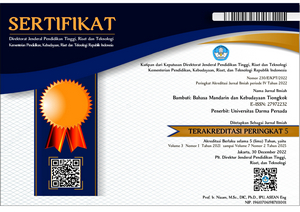Emotional Expression of the Interjection 哎呀 Aiya
Ekspresi Emosional Interjeksi哎呀Aiya
Abstract
Interjection has no concrete meaning like noun, verb, nor adjective. It appears in spoken language to express one’s emotion in a certain condition or situation. The interjection 哎呀 aiya is one of the most frequently used interjection in modern Chinese. Concerning哎呀, Oxford Concise Chinese Dictionary (2010:1) only mentions that 哎呀is used to express surprise or discontent. We presume that there are more emotions available to be expressed. Based on the lack of types of emotions in the Chinese dictionary, the aim of this research is to examine kinds of emotions by analyzing the spoken language from a Chinese drama. The data is taken from dialogues containing 哎呀. This allows the researchers to observe the types of positive and negative emotions of 哎呀 in detail. This research uses Paolo Santangelo’s theory of emotion. He classifies emotions into 5 categories: (1) positive expectation and interaction, (2) satisfactory affects, (3) negative projection, (4) aggressive-opposing emotions, and (5) unsatisfactory affects. The method used to ascertain the type of emotions is done by considering the context where 哎呀appeared. From the context, it will determine the type of emotions. The result shows that the interjection 哎呀can express 5 types of emotions, such as hope, empathy, surprise, happiness, satisfy, worry, fear, angry, etc. The novelty of this research is to give types of emotions in detail.

This work is licensed under a Lisensi Creative Commons Atribusi 4.0 Internasional.
Authors who publish with this journal agree to the following terms:
- Authors retain copyright and grant the journal right of first publication with the work simultaneously licensed under a Lisensi Creative Commons Atribusi 4.0 Internasional that allows others to share the work with an acknowledgment of the work's authorship and initial publication in this journal.
- Authors are able to enter into separate, additional contractual arrangements for the non-exclusive distribution of the journal's published version of the work (e.g., post it to an institutional repository or publish it in a book), with an acknowledgment of its initial publication in this journal.
- Authors are permitted and encouraged to post their work online (e.g., in institutional repositories or on their website) prior to and during the submission process, as it can lead to productive exchanges, as well as earlier and greater citation of published work (See The Effect of Open Access).









